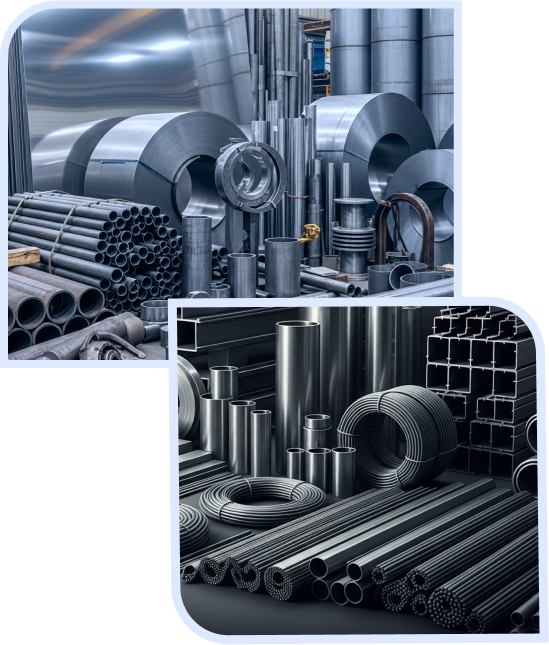Threaded Pipe Fittings
What are Threaded Pipe Fittings?

Threaded Pipe Fittings are forged components used to connect pipes and equipment by means of screw threads, providing a secure, leak-resistant joint in small-diameter, high-pressure piping systems. Unlike welded connections, threaded fittings do not require welding or heat, making them ideal for quick installation, dismantling, and repair.
These fittings are widely used in low to medium-pressure fluid systems, particularly where piping runs require frequent modifications or maintenance. Threaded fittings are available in a variety of types such as elbows, tees, unions, couplings, plugs, bushings, and more, typically produced from carbon steel, stainless steel, and alloy steel.
Key Features
- Leak-Proof Design – The welded joint ensures no leakage under pressure or vibration.
- Strong Connection – High structural integrity suitable for vibration-prone systems.
- Space-Saving – Compact dimensions ideal for tight or small-area installations.
- Material Versatility – Available in CS, SS, Duplex, and high-temp alloys.
- Standard Compliance – Adheres to ASME B16.11, MSS-SP, and DIN standards.
Types of Threaded Pipe Fittings
- Elbow
- Tee
- Socket
- Reducer
- Union
- Cross
Specifications
Mechanical Properties
Chemical Composition
Equivalent Grades
Weight Chart
Specifications
| Parameter | Details |
|---|---|
| Sizes | ⅛" to 4" (DN6 – DN100) |
| Thread Standards | NPT, BSP, BSPT, ISO Metric |
| Pressure Ratings | Class 2000 / 3000 / 6000 |
| Material Options | Carbon Steel, SS 304 / 316, Duplex, Alloy Steel |
| Standards | ASME B16.11, MSS-SP-83 / 95, BS 3799 |
| Manufacturing | Forged & Machined, Thread Rolled |
| Property | Typical Value |
|---|---|
| Tensile Strength | 485 – 700 MPa (varies by grade) |
| Yield Strength | 250 – 450 MPa |
| Elongation | 20% – 30% |
| Hardness | 125 – 250 HB (Brinell) |
| Temperature Range | -46°C to +600°C |
| Element | Composition (%) |
|---|---|
| Carbon (C) | 0.08 – 0.35 |
| Manganese (Mn) | 0.60 – 1.65 |
| Silicon (Si) | 0.15 – 0.80 |
| Chromium (Cr) | 18.0 – 20.0 (Stainless Steel) |
| Nickel (Ni) | 8.0 – 10.5 (SS 304/316) |
| Molybdenum (Mo) | 2.0 – 3.0 (in F316) |
| Phosphorus (P) | ≤ 0.035 |
| Sulfur (S) | ≤ 0.040 |
| Iron (Fe) | Balance |
| Standard | Equivalent Grade |
|---|---|
| ASTM | A105 (CS), A182 F304/F316 (SS), A350 LF2 |
| ASME | B16.11 |
| MSS-SP | SP-83, SP-95 |
| BS | 3799 |
| DIN | 2950, 2975 |
| Fitting Type | Size (inches) | Weight per 100 pcs (kg) |
|---|---|---|
| Threaded Elbow | ½" | 8.20 |
| Threaded Tee | 1" | 12.50 |
| Full Coupling | ¾" | 9.80 |
| Hex Head Plug | 1¼" | 7.90 |
| Threaded Union | 2" | 18.00 |
Applications of Threaded Pipe Fittings
Construction &
Infrastructure
Automotive & Heavy
Equipment
Manufacturing &
Fabrication
Medical & Laboratory
Equipment
Electrical &
Electronics Assembly
Oil, Gas & Petrochemical
Installations
Do you have questions?
Are threaded fittings suitable for high-pressure applications?
Yes. Threaded fittings rated for Class 3000 and 6000 can withstand significant pressure, but welded fittings are preferred for extreme or critical applications.
Can I reuse threaded fittings after dismantling?
Yes, provided the threads are not damaged or deformed. Use new PTFE tape or thread sealant upon reinstallation.
What’s the difference between NPT and BSP threads?
NPT (National Pipe Thread) is tapered and common in North America, while BSP (British Standard Pipe) is used globally. Matching threads is crucial to avoid leakage.
Do you offer fittings with special coatings or finishes?
Yes. We offer zinc plating, black oxide, Teflon-coated, and epoxy-coated threaded fittings for corrosive or harsh environments.


